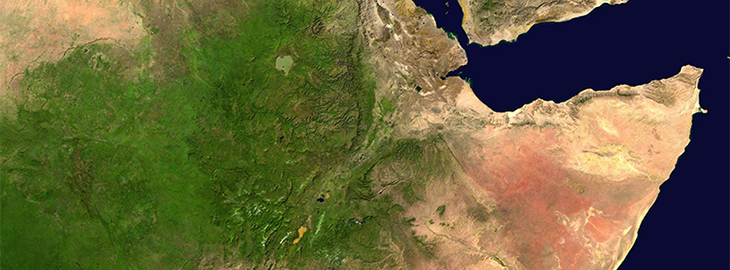Climatology and interannual variability of Eastern Horn of Africa boreal spring wet season precipitation and implications for its recent decline
Surrounded by a ring of mountains that include some of the continent’s tallest peaks, the eastern Horn of Africa has a unique climate, since it is almost completely cut off from the rest of the continent. In stark contrast with the rest of near-equatorial Africa, this region has a primarily dry climate and experiences two distinct wet seasons each year. Other regions at this latitude receive rainfall almost entirely in a single wet season that occurs between June and September.
In the eastern Horn, local agriculture is almost exclusively rainfed, and rainfall amounts have always been too variable to allow for consistent food security. Of the two wet seasons, the March–May wet season historically has provided more average precipitation and has been more reliable than the October–December season, accounting for more than 70 percent of agricultural output. Since the early 1980s, however, precipitation over the eastern Horn has decreased during the March–May season. In particular, since the late 1990s almost every March–May season has been dry. The prevailing theory to explain this drying is that as precipitation and atmospheric heating was increased over Indonesia, the result is an increase in upper-level easterly winds over the Indian Ocean and enhanced subsidence over the eastern Horn.
In a new study published in the May issue of the Journal of Climate, CIRES and ESRL researchers, and their collaborators, examine the 1981–2014 climatology and variability of the eastern Horn’s March-May wet season—looking at precipitation, upper- and lower-level winds, low level water vapor, and convective available potential energy—to better understand how the spring wet season is established, and the possible causes of the recent observed decline.
This study advances understanding of the fundamental physics of the weather and climate of Eastern Africa during the critical March-May rainy season, thereby providing a better conceptual model for prediction. Improved predictability of Eastern Africa precipitation provides opportunities for flooding and drought early warning, and betters the prospects for forecasting a constantly evolving food security situation over this water-scarce region.
Posted: May 19, 2017

Authors of Climatology and interannual variability of Eastern Horn of Africa boreal spring wet season precipitation and implications for its recent decline are Brant Liebmann, Dave Allured, Xiao-Wei Quan, Martin Hoerling, and Andrew Hoell of the Physical Sciences Laboratory; Ileana Bladé of Grup de Meteorologia, Universitat de Barcelona, Spain; Pete Peterson of the Climate Hazards Group, University of California; and Wassila Thiaw of NOAA's Meteorological Development Laboratory.